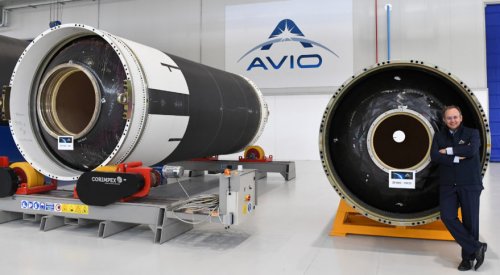WASHINGTON — Avio, the company that builds Europe’s light-lift Vega rocket and the future Vega C, reported a double-digit jump in revenue for its first full year as a publicly traded company.
Based in Colleferro, Italy, near Rome, Avio said March 14 that revenue for 2018 increased 13 percent to 388.7 million euros ($440.6 million), and net profit by 18 percent to 25.8 million euros.
Avio said faster than expected progress on next-generation projects it is working on with the European Space Agency caused the company to pass its upper revenue projection of 365 million euros.
The Vega C rocket, Europe’s successor to the current Vega rocket, and the P120C booster that will serve as both the strap-on for Ariane 6 and the first stage of Vega C, advanced at a rate that triggered higher 2018 revenues than initially forecast, Avio said.
Vega C, which is designed to carry about 700 kilograms more than the current Vega rocket, slipped from a maiden flight this year to early 2020 — a schedule shift Avio attributed to its 2019 manifest and not delays with the rocket.
Avio has four Vega launches this year: the Italian Space Agency’s PRISMA remote sensing satellite, the proof of concept flight of the ESA-supported SSMS adaptor for cubesats and larger microsats, and launches of the United Arab Emirates’ Falcon Eye 1 and 2 satellites. Barring delays, it will be the highest number of Vega launches in a single year since the rocket’s debut in 2012.
“What is behind our business is a very rapidly growing segment of the market,” Avio CEO Giulio Ranzo said in an interview. “All of these low Earth orbit small satellites, one way or another they are growing very fast.”
Avio competes mainly with the Indian space agency ISRO’s Polar Satellite Launch Vehicle, but also counts Northrop Grumman’s Minotaur rockets and Firefly Aerospace’s future Alpha vehicle as competitors.
Arianespace of Evry, France, markets Avio’s rockets, and indicated early this year that may soon need to purchase more. Ranzo said it’s not clear how many rockets Arianespace would buy — the last contract was for a mix of 10 Vega and Vega Cs — but that an order could come through this year or in early 2020.
Avio’s backlog for 2018 was 877 million euros, down 8 percent. The company described its backlog as “cyclical,” forecasting a decrease to 750 million to 800 million euros for 2019. In February 2018 Avio also recorded its final order of Ariane 5 strap-on solid rocket boosters for the rocket’s last 10 missions.
Ranzo said physical upgrades to the Vega launch pad in Kourou, French Guiana, have been completed to support Vega C, which is about 5 meters taller and roughly 70 tons heavier than Vega.
Ranzo said Avio is continuing to study building a “microlauncher” that would compete with smaller vehicles like Rocket Lab’s Electron and Virgin Orbit’s LauncherOne.
Avio’s vehicle, referred to in a March 15 presentation as “Vega Light” would be capable of launching 250 to 300 kilograms to low Earth orbits around 400 to 500 kilometers, Ranzo said.
“We are working through the preliminary design review in the development,” he said. “Our requirement is having as much commonality as possible with Vega C.”
Ranzo said Vega Light would be an entirely solid-propulsion rocket, eliminating the need to fuel rocket stages on the launch pad immediately before flight. A full launch campaign could take less than five days, he said, because all solid-propellant rockets could be built and stored away until needed.
ESA is conducting studies with Avio and other companies on European microlaunchers, leading up to the agency’s ministerial conference this November where it plans to propose a program that would support “privately-led privately-funded space transportation services, with an initial focus on launch services based on microlaunchers.”
- Ariane 6 is nearing completion, but Europe’s work is far from over
- Why Sierra Nevada’s owners are betting big on Dream Chaser
- Avio expanding Vega launch abilities, mulls “light” mini-variant
- SpaceX takes top honors in SpaceNews Awards for Excellence & Innovation
- Small-rocket-builder Avio raises $66 million through stock listing
Share with your friends

(0) Comments
This article comments are currently no :(